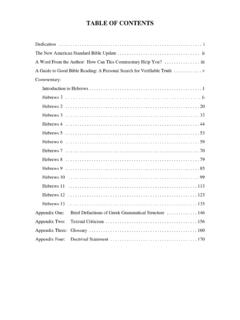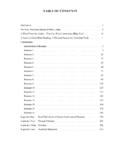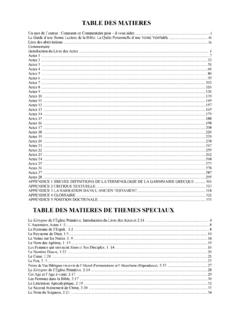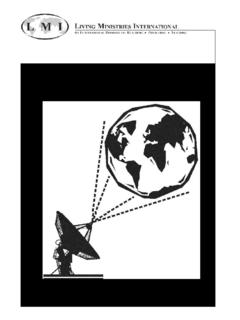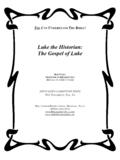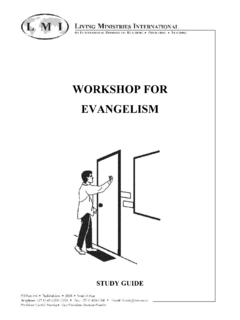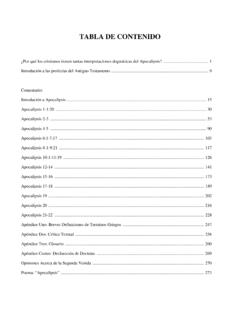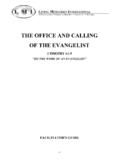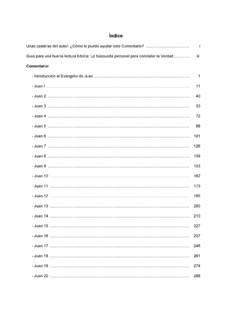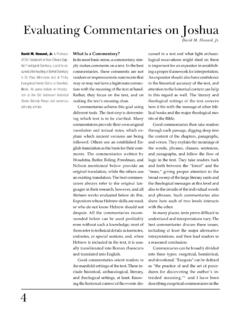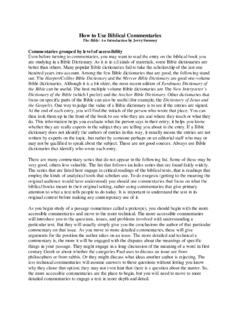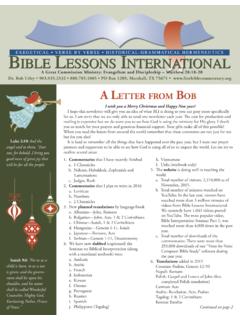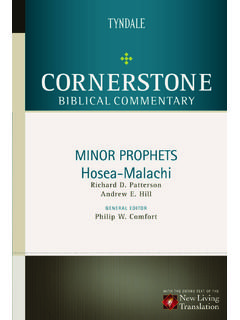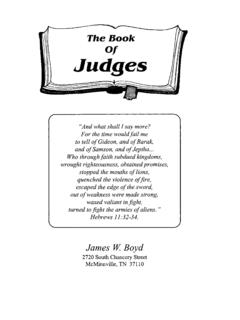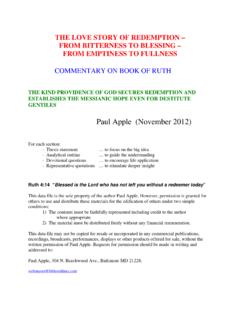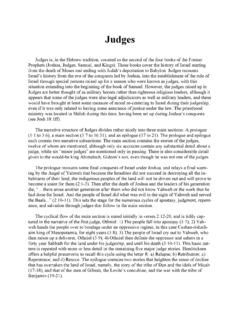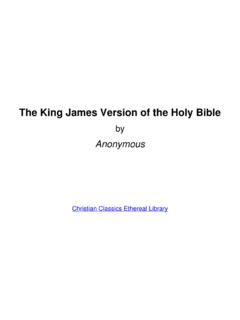Transcription of Judges, Ruth Bible commentaries
1 YOU CAN UNDERSTAND THE BIBLEJUDGES, RUTHBOB UTLEYPROFESSOR OF HERMENEUTICS( Bible INTERPRETATION)STUDY GUIDE COMMENTARY SERIESOLD TESTAMENT VOL. 4 BBIBLE LESSONS INTERNATIONALMARSHALL, TEXAS20155 INTRODUCTION TO JUDGESI. NAME OF THE BOOKA. The title comes from the Hebrew VERB shophetim (BDB 1047, KB 1622, Qal ACTIVEPARTICIPLE), which meant to settle a dispute. This Hebrew term is similar to (R. K. Harrison,Introduction to the Old Testament, p. 680):1. the Canaanite term for leader or prince (cf. Amos 2:3)2. the Phoenician term for regent 3. the Akkadian term for ruler 4. the Carthaginean term, chief magistrate B. It was translated in the LXX as krital or Our English title came from the Vulgate s The English title is misleading because these persons do not act in judicial ways but are dynamiclocal leaders raised up by God, empowered by His Spirit (cf.)
2 Jdgs. 3:10; 6:34; 11:29; 14:6,19;15:14), to meet the specific purpose of delivering His people from a foreign oppressor (cf. :16). A better title might be Deliverers (BDB 446, cf. Jdgs. 3:9,15).II. CANONIZATIONA. This is the second book of the second division of the Hebrew canon. It is called the This second division has two sub-divisions:1. the former prophets which we call the historical books: Joshua Kings (except ruth )2. the latter prophets which we call the prophets: Isaiah Malachi (except Daniel andLamentations)III. GENRE This is primarily historical AUTHORSHIPA. The Bible itself is Bathra 14b (a book of the Talmud) says Samuel wrote the books which bears his name, judges , and judges covers a period of many years ( , death of Joshua to birth of Samuel), therefore, therecannot be one eyewitness The book was possibly compiled from:1.
3 Several unnamed written sources such as:a. The book of the Wars of the Lord, which is one historical source mentioned inNumbers 21:146b. The book of Jashar, which is another historical source mentioned in Joshua 10:13and 2 Samuel 1:182. possibly several oral sources. Accurate oral histories were common in the Ancient NearEast where writing materials were very expensive and difficult to carry. See John and D. Brent Sandy, The Lost World of Scripture, which discusses how oralsocieties passed on their history and traditions. An example would be: The Chronicles ofSamuel the seer,..Nathan the prophet,..Gad the seer in 1 Chr. 29 It seems that the original compiler wrote during the early United Monarchy:1. Bethlehem is mentioned often, possibly reflecting David s day (cf. Jdgs. 17:7,8,9; 19:1,2,18[twice]).2. Several texts reflect a monarchial period by the phrase in those days there was no king inIsrael (cf.)
4 Jdgs. 17:6; 18:1; 19:1; 21:25). There were kings in all the surrounding nations,though not in There is evidence of a later editor:1. judges 18:30 reflects:a. the Assyrian exile of the northern ten tribes in 722 ( , the fall of Samaria)b. possibly the capture of the Ark by the Philistines in Eli s day, 1 Samuel 1-72. Jewish tradition asserts that Jeremiah and/or Ezra the scribe edited parts of the OT. Theformation of the OT in its current form is lost to us. However, this does not affect thedivine inspiration of these OT books. See Special Topic: The Bible (its uniqueness andinspiration) and Special Topic: DATEA. Although written by a compiler, probably during David s reign, this does not imply that thehistorical material is not from eyewitness sources. There are two good examples of this:1. In Jdgs. 1:21 the Jebusites still hold the inner fortress of Jebus (later Jerusalem).
5 Daviddoes not conquer this fort until 2 Sam. 5:6ff. See Special Topic: In Jdgs. 3:3 Sidon, not Tyre, is listed as the major city of The book covers the period of time from immediately after the conquest of Joshua to the birthof Samuel. The beginning date depends on the date of the Exodus (1445 or 1290 ; seeSpecial Topic: Date of the Exodus), 1350 or 1200 The terminus date would be about1020 , which is the beginning of Saul s reign (Bright).C. If one adds up all of the dates given for the judges , it comes to 390-410 years. This cannot betaken chronologically sequential because from 1 Kgs. 6:1 the Bible says there were 480 yearsbetween the Exodus and the building of Solomon's Temple, 965 This means the judges musthave been primarily local leaders and their dates must The rebellious events recorded in judges 17-21 occur at the beginning of the period, which showsthe book is out of chronological HISTORICAL SETTING7A.
6 The beginning chapters of judges show us how limited was the conquest of Joshua. Joshuabasically defeated the major Canaanite walled cities and their military potential. God left thehard job of occupation to each of the tribes in their own area, Jdgs. 2:6. This strategy was to testthe new generation of Israelites who had not seen God s miracles of the Exodus and Conquest,Jdgs. 2:1-10; 3 The new generation failed the test, Jdgs. 2:11ff; 3:7,12; 4:1; 6:1; 10:6; 13:1; see Special Topic:God Tests His People (OT). God responded to their sin by sending foreign oppressors to punishHis people. The people repented and cried out to God for help. God sent a deliverer. Thenfor a period of years the land was peaceful. This is basically the pattern that describes the bookof judges , Jdgs. 2:6-16:31 (sin, sorrow, supplication, salvation, and relapse).VII. LITERARY UNITSA.
7 It seems that the time of the judges is theologically described in three different ways. These threeperspectives form the outline of the book:1. results of Joshua s conquest2. the need for deliverers3. examples of apostasyB. Brief Outline of the Book:1. a brief account of the conquest, Jdgs. 1:1-2:52. the sin, judgment and deliverance of God s people, Jdgs. 2:6-16:313. three examples of the sins of God s people that reveal the moral climate of the day:a. Micah s idolatry, judges 17b. Dan s migration, judges 18c. Gibeah s sexual sin, judges 19-21C. The Major judges and their enemies: NAME TEXT ENEMYTIME of PEACE (1) orTIME of JUDGING (2) 1. Othniel 3:7-11 Mesopotamia (Cushan-Rishathaim) 40 yrs. (1) 2. Ehud 3:12-30 Moab (Eglon) 80 yrs. (1) 3. Deborah (Barak) 4:1-24 (prose) 5:1-31 (poetry) Canaanite (Jabin and Sisera) 40 yrs.
8 (1) 4. Gideon 6 - 8 Midianites & Amalekites 40 yrs. (1) 5. Jephthah 10:17-12:7 Ammonites (& Ephraim) 6 yrs. (2) 6. Samson 13 - 16 Philistines 20 yrs. (2) D. The Minor judges : Name TextEnemy Time of Judging1. Shamgar 3:31 Philistines?82. Tola 10:1-2 ? 23 Jain 10:3-5 ? 22 Ibzan 12:8-10 ? 7 Elon 12:11-12 ? 10 Abdon 12:13-15 ? 8 Abimelech, 9:1-57:1. this was a son of Gideon by a concubine2. he only affected one city, Shechem3. he is different from the other JudgesVIII. MAIN TRUTHSA. This book clearly shows the continuing results of the Fall (see Special Topic: The Fall):1. Each successive generation violated the Covenant and went after Canaanite fertility gods(see Special Topic: Fertility Worship of the Ancient Near East).
9 2. Even in the Promised Land, with its tribal allocations given by God, the tribe of Dan choseto relocate to the extreme north instead of trusting God to defeat the God used pagan peoples to judge His people (later Syria, Assyria, and Babylon). This reflectsthe cursing sections of Leviticus 26 and Deuteronomy 27-29; also note Deut. 7:1-5,17-26; 20:16-18C. This book shows the need for a righteous King (one who reflects YHWH s character) to lead theunited tribes (cf. Jdgs. 17:6; 18:1; 19:1; 21:25).D. YHWH is faithful even when Israel is not! His people s continual covenant disobediencehighlights His character ( , mercy, grace, longsuffering, love); see Special Topic:Characteristics of Israel s God (OT).E. This book continues the history of the Jewish people which began in Genesis, especially thecovenant with Abraham (see Special Topic: Covenant Promises to the Patriarchs).
10 9 judges 1 PARAGRAPH DIVISIONS OF MODERN TRANSLATIONSNASBNKJVNRSVTEVNJBJ erusalem Is CapturedThe Continuing Conquestof CanaanThe Period of the judges (1:1-2:5)The Tribe of Judah andSimeon Capture Adoni-bezekThe Settlement of Judah,Simeon, Caleb and theKenites1:1-71:1-71:1-71:11:1-81:21:3- 7 The Tribe of JudahConquers Jerusalem andHebron1:8-101:8-151:8-151:8-101:9-15 Capture of Other CitiesOthniel Conquers the Cityof Debir1:11-151:11-15 The Victories of the Tribeof Judah and Benjamin1:16-211:16-211:16-211:16-211:16 1:17-19 The Tribes of Ephraim andManasseh Conquer Bethel1:20-21 The Tribes of Ephraim andManesseh Capture BethelThe Capture of Bethel1:22-261:22-261:22-261:22-261:22-2 6 Places Not ConqueredIncomplete Conquest of theLandPeople Who Were NotDriven Out by the IsraelitesThe Northern Tribes1:27-281:27-281:27-281:27-281:27-3 51:291:291:291:291:301:301:301:301:31-32 1:31-321:31-321:31-321:331:331:331:331:3 4-361:34-361:34-361:34-351:361:36 READING CYCLE THREE (from "A Guide to Good Bible Reading")10 CONTEXTUAL INSIGHTSA.
